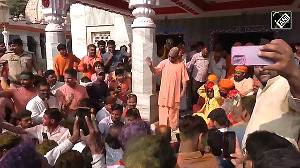As students from some of India's most privileged educational institutions continue their protests against reservations for socially disadvantaged OBCs (Other Backward Classes), it becomes clear that the agitation has not been a spontaneous, but a highly organised and orchestrated phenomenon.
At least three groups of people have played a role in sustaining it: upper caste-dominated professional guilds like the Indian Medical Association; captains of industry and owners of private colleges, who stridently oppose any extension of Dalit-Adivasi (Scheduled Castes-Scheduled Tribes) reservations; and Bhartiya Janata Party politicians.
How far will the student protest go
Weighty evidence for this comes both from the participation in the agitation by executives of Information Technology companies, and from the disclosure that 'event management' specialists -- who charge hefty fees -- were hired to foment protests in Mumbai. Evidently, many tycoons decided to kill the very idea of affirmative action in educational institutions -- so it can't be extended to the private sector, as the government proposes to do.
Those who run private capitation-fee colleges also have a huge stake, running into thousands of millions of rupees, in opposing affirmative action. A year's delay in implementing quotas means that private institutions, with an intake of over 534,000 students, could make landfall profits of the order of Rs 10 billion (Rs 1,000 crores) to Rs 25 billion (Rs 2,500 crores) by selling seats which would have gone to OBCs.
+Regrettably, even the National Knowledge Commission played a partisan role in the whole business. First, off its own bat, it opposed OBC reservations and publicised its opposition through its majority (6:2) report. Then, two members decided to quit, adding more grist to the anti-affirmative action mill. They couldn't have been unaware that their action would raise the pitch of the crusade against affirmative action in favour of disadvantaged groups per se.
'We can't build the nation with 19th century mindset'
The agitation put at stake not just the fate of Human Resources Development Minister Arjun Singh's limited proposal to introduce 27 per cent reservation for OBCs in all central universities and institutions like the Indian Institutes of Technology and of Management. It attacked the fundamental principle of affirmative action itself. This would have jeopardised the hard-earned gains of India's social reform movement.
Had the agitation succeeded, India would have turned its back on the imperative of correcting the distortions and inequalities caused by unbalanced growth over the past decade or more of neoliberal or 'free market' policies.
The inspiration behind the anti-affirmative action agitation had nothing to do with promoting the public interest or any universal collective or national objectives. Rather, it was driven by a highly individualistic urge to defend and extend privilege against the common good. The bulk of the agitating students are children of the new middle class which burgeoned under the inequality-enhancing, skewed and dualistic economic policies launched in 1991.
Many of them don't see the unprecedented prosperity and rising incomes of a small minority -- namely, themselves -- as the result of certain larger economic processes and forces, such as higher rates of savings, the Indian state's elitist macroeconomic and taxation policies, or globalisation, which has given rise to new technologies and divisions of labour, thus creating new opportunities in IT and related services.
Even less are they aware that their own prosperity is the obverse of, and rooted in, the squalor of the majority and the further squeezing of India's most backward regions and the fragile economies of the labouring poor. Rather, they attribute it to their own 'talent', 'merit' and individual initiative. They oppose affirmative action because they want to perpetuate the status quo and grab the opportunities it offers -- to the exclusion of the vast majority.
Supporters of the anti-affirmative action agitation take refuge behind many specious (or half-valid) arguments and dubious data: for instance, that affirmative action will kill or devalue 'merit'; that Other Backward Classes and even Scheduled Castes and Scheduled Tribes, are already fairly well-represented in many professions, according to a 1999 National Sample Survey Organisation estimate; and that in any case, the benefits of educational quotas in institutions will inevitably be cornered by the 'creamy layer' of the OBCs, which is already politically privileged or affluent.
The 'merit' argument is bogus, in fact disingenuous, especially in a society based on inheritance of private property, and privilege related to birth, which largely determine one's social position. Property inheritance means that the affluent are at a vastly different, higher starting point from the disadvantaged. Merit makes sense only when it measures the distance between the starting point and the end point. Most upper-caste people enjoy unfair advantage over OBCs or lower castes primarily because of their disparate starting points. Merit is only one, usually small, component of their overall achievement.
Merit is not easy to measure, quantify or compare. A single 'objective test' is a disputable measure. One's score in it often depends upon familiarity with the type of questions asked, time management and speed, rather than comprehension. Merit can only have a limited place in a public-oriented policy of admission and recruitment. In a large country like India, other criteria are equally relevant: for instance, gender, ethnic and regional balance, and diversity.
'What more do the upper castes want?'
The fundamental point is that a person born in a highly educated savarna family will have a totally different universe of knowledge, social contacts and elite acceptability -- and wholly different access to information about the availability of study courses, colleges and private tutorial institutions, career options, professional advice, etc. S/he can always call 'Uncle' so-and-so in the civil service, judiciary or the medical profession to get useful tips.
Typically, such advantage outweighs even (small) differences of wealth and income. Past discrimination continues to produce inequality of opportunity even when there is no discrimination or exclusion at present. The critical issue is how to level the playing field so as to give genuinely equal opportunity to the disadvantaged.
Affirmative action is the best, if not only, solution to this problem. It can take many forms, including voluntary targets set by institutions and companies for recruitment of disadvantaged groups, special counselling and training, non-quantitative diversity promotion programmes, etc. Reservations, admittedly, are a rather blunt instrument with which to crack the problem. A case can be made out that in India we have used reservations as the sole form of affirmative action. But this should not be used to make the best the enemy of the good.
As for the 'factual' argument cited by many affirmative action opponents, namely that OBCs have nearly the same level of representation as their population share in numerous professions, including in private sector jobs, the evidence from the NSSO is dubious. The NSSO is simply not equipped to identify hundreds of local caste groups accurately.
Caste identification is the job of highly specialised anthropologists, sociologists and historians familiar with caste configurations which vary from district to district. Neither self-ascription nor crude state government caste lists can be a substitute for this.
The NSSO data seems be of very poor integrity. This should be obvious from the fact that it estimates the SC/ST population at 28.5 per cent of the country's total -- when the highest credible estimate is 23 per cent.
A lot of rage, a little Rang De
The 'creamy layer' argument is certainly valid. Social and educational backwardness is a changing phenomenon. There is upward mobility among the OBCs. But it doesn't follow that their upper layers will automatically corner quotas. They can and should be excluded from doing so along some of the criteria specified by the Supreme Court in the Mandal judgment. After all, only half of India's OBCs (52 per cent of the total population) can get accommodated under the 27 percent quota. It is imperative to ensure that this is the lower half, not the upwardly mobile, relatively privileged layer.
It would be ideal in the long term if different institutions and governments could devise varying affirmative action formulae based upon a number of different criteria besides caste -- including gender, economic status of family, quality of schooling received by parents, backwardness of region of origin, etc. Delhi's Jawaharlal Nehru University has a decade-old admissions policy which gives extra points to OBCs, women and regional backwardness over and above a candidate's entrance examination score. This has significantly raised JNU's OBC intake.
Some social scientists, including JNU's Purshottam Aggarwal, and Delhi University's Satish Deshpande, with Yogendra Yadav, have proposed affirmative action formulae assigning different weights to these factors. Despite their drawbacks -- controversially opening up the SC/SC quota, or providing an inadequate boost to OBCs -- these proposals should be seriously debated at length. However, the topmost priority last fortnight was to beat back the challenge posed by the anti-quota agitation, which opposed the very principle of affirmative action.
The United Progressive Alliance government did well to uphold the principle and stick to the 27 per cent OBC quota. Wisely, it didn't resort to the undesirable device of phased implementation. But it will have to increase the total number of seats in central educational institutions by 54 per cent within a year, at an estimated expense of Rs 80 billion (Rs 8,000 crores). This is a formidable, but worthwhile, task. One can only hope that the upper castes accept reservations in the spirit of justice and of creating a caring-and-sharing society.






 © 2025
© 2025